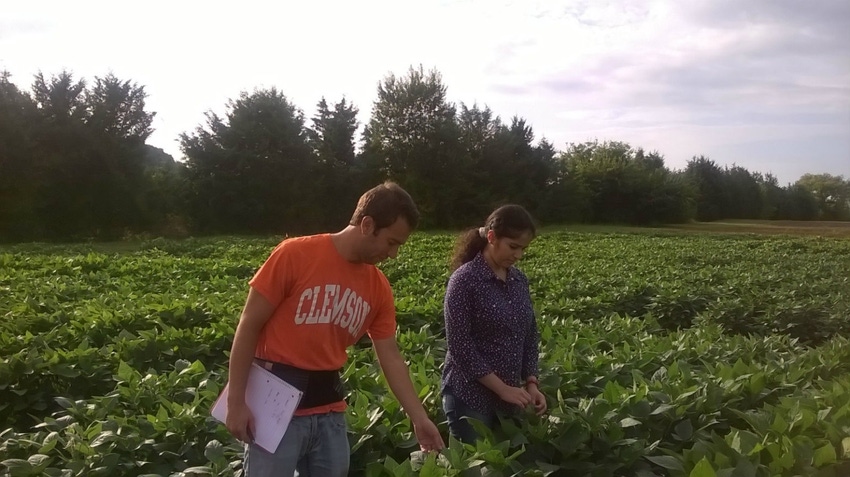
While plants may look healthy on top, what goes on underground could wipe out an entire crop.
This is why a team of Clemson scientists is studying soybean plant roots to understand the roots’ ability to penetrate hardpan soil and gather nutrients and water from the soil. The goal is to someday create plants with roots that extend deeper into the ground, making them more drought-tolerant and nutrient-efficient.
Harrison Fried, a master’s student in Plant and Environmental Sciences from Baltimore and his major professor, Sruthi Narayanan are working with Clemson soybean breeder Ben Fallen of the Pee Dee Research and Education Center for this study. The team published their findings in the scientific journal PLOS ONE.
The soybean team is part of a larger effort by Clemson’s College of Agriculture, Forestry and Life Sciences to create crop varieties optimized for Southeastern growing conditions.
“Most crop improvement programs focus on the above ground portion of plants,” Fried said. “From what we could find, there have been very few studies on just the roots. Without a good root system, it’s difficult to produce good yields. This study looks at what soybean varieties can be grown in arid regions, as well as regions with hardpan-forming soils.”
Data from the National Integrated Drought Information System’s U.S. Drought Portal shows than one-quarter of the South Carolina land is considered to be in a severe drought. The worst of the drought conditions are confined to a stretch of land across the middle of the state – including the Pee Dee Region where much of South Carolina’s crops are grown. In addition to being prone to drought conditions, the Pee Dee Region also contains sandy soils, a major contributor to soil hardpans.
“One concern is that during the growing season, especially if a drought occurs, the ground can become hard as it dries out,” Fallen said. “Regardless if this happens or to what extent, having a more prolific root system is a good trait.”
Hardpans are soils with higher sand content, which are more common in lands closer to the coast. These soils can form a “hardpan,” usually at a depth of 10 to 16 inches that can be 2 to 8 inches thick. The hardpan can block roots from reaching the depths necessary for plant health.
“This is why it is a bigger problem for South Carolina growers than for growers in other areas, such as the Midwest,” Fallen said.
Ploughing, or subsoiling, land before planting can help break up hardpans to help roots reach water and other nutrients well below ground surface. But not all soybeans planted in South Carolina are planted behind a subsoiler. Some are drilled or planted using other methods, which leaves the hardpan untouched. If not tilled, the hardpan prohibits roots from reaching water and nutrients found in deeper soil. Most soybeans in South Carolina are planted 3/4 inches deep, depending on planting conditions and weather.
There are other advantages of having roots penetrate the hardpan and farmers not have to plough. “It minimizes soil disturbances and maintains sustainability, whereas subsoiling, which is expensive in terms of time and energy, is non-sustainable,” Narayanan Said.
The researchers used 49 genotypes from a soybean germplasm collection for this study. Fried said the results were “exciting,” noting roots from one slow-wilting plant type (NTCPR94-5157) penetrated the hardpan. Fried said this is what the researchers were hoping for.
“The goal of this study is to identify genotypes with root characteristics that allow plants to tolerate drought and/or capture water and nutrients more efficiently,” Narayanan said. “The knowledge we gained from this study is critical for designing root systems that help improve yields.”
The team has already taken this study to the next level as they are currently studying soybean root systems in relation with water use efficiency and yield. The improved genotypes their studies identify will be used for developing soybean varieties not only for South Carolina, but also for the Southeast.
Soybeans are a major crop in South Carolina with the United States Department of Agriculture National Agricultural Statistics Services reporting 400,000 acres planted in 2017.
About the Author(s)
You May Also Like






